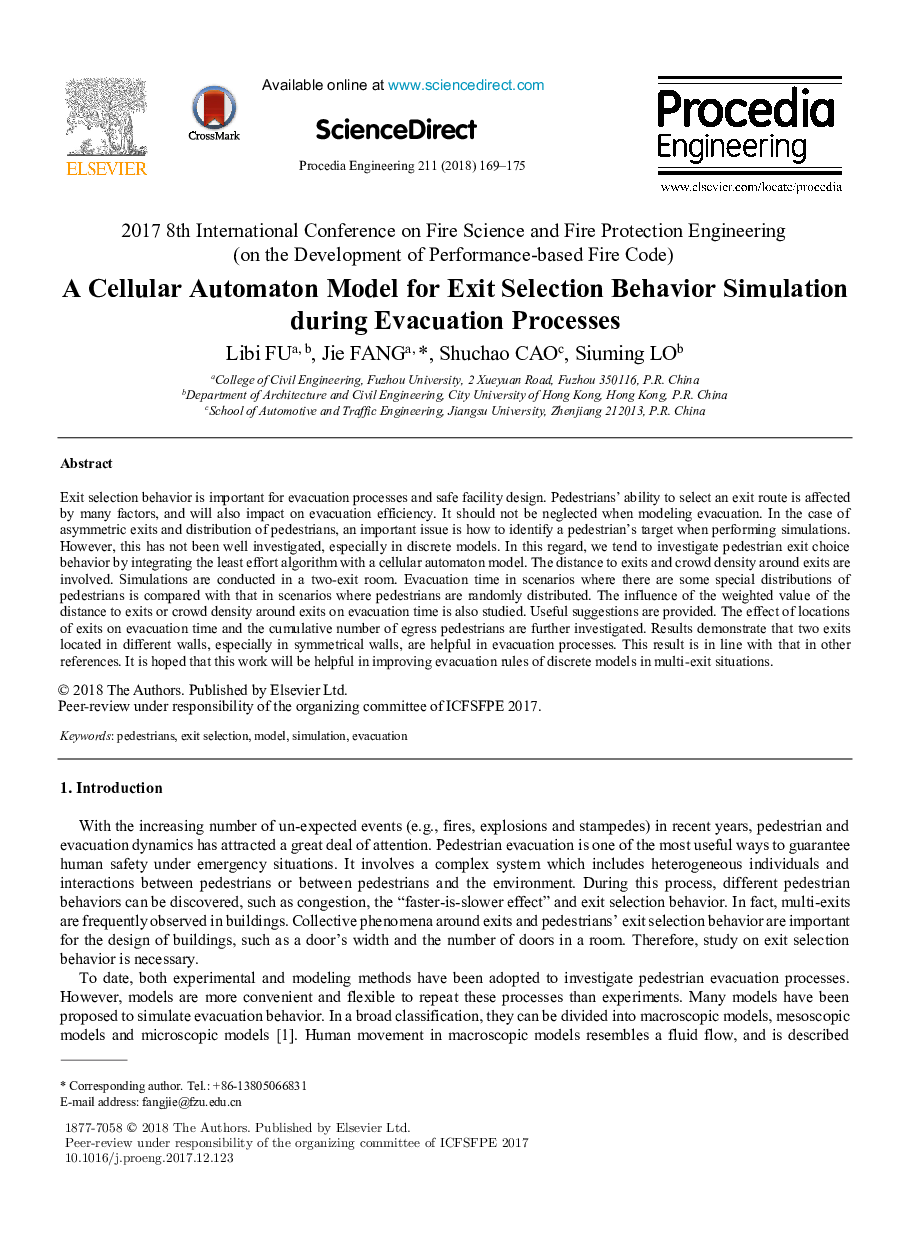| کد مقاله | کد نشریه | سال انتشار | مقاله انگلیسی | نسخه تمام متن |
|---|---|---|---|---|
| 7226207 | 1470612 | 2018 | 7 صفحه PDF | دانلود رایگان |
عنوان انگلیسی مقاله ISI
A Cellular Automaton Model for Exit Selection Behavior Simulation during Evacuation Processes
ترجمه فارسی عنوان
مدل اتوماتیک سلولی برای شبیه سازی رفتار خروج از انتخاب در طی فرایندهای تخلیه
دانلود مقاله + سفارش ترجمه
دانلود مقاله ISI انگلیسی
رایگان برای ایرانیان
کلمات کلیدی
عابر پیاده، انتخاب خروج، مدل، شبیه سازی، تخلیه،
ترجمه چکیده
رفتار خروج از خروجی برای فرایندهای تخلیه و طراحی ایمن امکانات مهم است. توانایی پیاده روی برای انتخاب مسیر خروج از عوامل بسیاری است و همچنین بر راندمان تخلیه تأثیر می گذارد. در هنگام مدل سازی تخلیه نباید آن را نادیده گرفت. در مورد خروجی نامتقارن و توزیع عابرین پیاده، یک مسئله مهم این است که چگونه در هنگام شبیه سازی یک هدف عابر پیاده را شناسایی کنیم. با این حال، این به خوبی مورد بررسی قرار نگرفته است، به ویژه در مدل های گسسته. در این راستا، ما با استفاده از الگوریتم کمترین تلاش با یک مدل اتوماتیک سلولی، رفتار انتخاب انتخاب عابر پیاده را بررسی می کنیم. فاصله تا خروج و تراکم جمعیت در اطراف خروجی ها. شبیه سازی در یک اتاق دو خروجی انجام می شود. زمان تخلیه در سناریوهایی که توزیع خاصی از عابران پیاده وجود دارد با آن در صحنه هایی که پیاده ها به صورت تصادفی توزیع می شوند مقایسه می شود. تاثیر ارزش وزنی فاصله تا خروج یا تراکم جمعیت در اطراف خروجی ها بر زمان تخلیه نیز مورد بررسی قرار گرفته است. پیشنهادات مفید ارائه شده است. تأثیر مکان های خروجی بر زمان تخلیه و تعداد تجمعی پیاده های خروجی بیشتر مورد بررسی قرار گرفته است. نتایج نشان می دهد که دو خروجی در دیواره های مختلف، به ویژه در دیوارهای متقارن، در روند تخلیه مفید هستند. این نتیجه در خطوط دیگر مطابقت دارد. امید است که این کار در بهبود قوانین تخلیه مدل های گسسته در موقعیت های چند خروجی مفید باشد.
موضوعات مرتبط
مهندسی و علوم پایه
سایر رشته های مهندسی
مهندسی (عمومی)
چکیده انگلیسی
Exit selection behavior is important for evacuation processes and safe facility design. Pedestrians' ability to select an exit route is affected by many factors, and will also impact on evacuation efficiency. It should not be neglected when modeling evacuation. In the case of asymmetric exits and distribution of pedestrians, an important issue is how to identify a pedestrian's target when performing simulations. However, this has not been well investigated, especially in discrete models. In this regard, we tend to investigate pedestrian exit choice behavior by integrating the least effort algorithm with a cellular automaton model. The distance to exits and crowd density around exits are involved. Simulations are conducted in a two-exit room. Evacuation time in scenarios where there are some special distributions of pedestrians is compared with that in scenarios where pedestrians are randomly distributed. The influence of the weighted value of the distance to exits or crowd density around exits on evacuation time is also studied. Useful suggestions are provided. The effect of locations of exits on evacuation time and the cumulative number of egress pedestrians are further investigated. Results demonstrate that two exits located in different walls, especially in symmetrical walls, are helpful in evacuation processes. This result is in line with that in other references. It is hoped that this work will be helpful in improving evacuation rules of discrete models in multi-exit situations.
ناشر
Database: Elsevier - ScienceDirect (ساینس دایرکت)
Journal: Procedia Engineering - Volume 211, 2018, Pages 169-175
Journal: Procedia Engineering - Volume 211, 2018, Pages 169-175
نویسندگان
Libi Fu, Jie Fang, Shuchao Cao, Siuming Lo,
